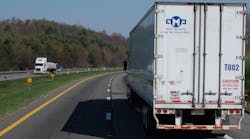ROSEMONT, IL. Capsulizing his latest predictions on where the U.S. economy is headed, Bill Witte, senior consultant with transportation-forecasting firm FTR Associates, said “my baseline forecast is [that we’ll see] more of the same for 2013 and then better [performance] in 2014.
“I use a forecasting model that was originally developed at Indiana University— it uses 242 variables and data back to 1980,” advised the kickoff speaker here at FTR’s State of Freight Summit. “The model is run and then its plausibility is evaluated and modified [if warranted].
Witte pointed out that his forecast is predicated on the assumption that there will be:
· Little change in inventories
· A steady rise in the stock market
· No change in exchange rate
· A gradual increase in consumer confidence
· No significant action taken by the Fed until late 2014
· Sequester cuts take effect mostly in 2Q and 3Q 2013
· No other significant changes in fiscal policy
· No [new] international debacles
All that being said, Witte then advised what percentage growth in key economic sectors he forecasts for next year-- as well as for “next year optimistic” and “next-year pessimistic”-- vs. the percentage-increase average performances turned in for those sectors in the last four quarters:
Sector Last 4Qs ’14 Forecast ’14 Optimistic ‘14Pessimistic
Consumer Consumption 2.0 2.7 2.8 1.5
Business Investment 4.1 3.8 6.0 3.0
Residential Investment 13.0 11.7 13.0 8.0
Government Spending -2.1 -1.1 0.0 -2.0
Exports 1.8 2.9 4.0 0.0
Imports 0.8 3.8 3.0 2.0
GDP 1.8 2.3 3.1 0.9
Next up was FTR senior consultant Larry Gross, who said his current outlook on rail carload growth certainly “reflects improvements in parts of the economy.”
He pointed out that last year drop-offs in coal and grain movements were “major drags” on rail carload growth. And while gains in petroleum freight “tried to make up the difference, [those carloads] did not succeed in doing so completely.”
According to Gross, the question right now is “whether improvements this year [in terms of seasonally adjusted rail carloads] in major commodity drags will be enough to offset other weakening?”
He related that recently the trend lines for carloads of coal and carloads without that commodity have merged— “meaning coal is no longer a drag.” He also said the lines related to total agricultural carloads vs. total loads and total loads without coal have merged as well— “so grain is no longer a drag, either.”
What’s more, Gross pointed out that the North American carloads year-over-year (YoY) percentage growth year to date, as reported by the American Assn. of Railroads (AAR), indicate that grain is now down 10%.
However, AAR shows the following commodity categories are up: crushed stone/sand/gravel by 11%; lumber/wood products by 8%; coke by 6%; chemicals by 2%-- and petroleum products by a whopping 43%.
Gross noted that "since the price of natural gas has come up, we believe we have reached the bottom curve of the coal shortage as well.”
As for his forecast for this year, he predicts the YoY percentage change for rail carloads will come in at 2.4% for 2013—that compares to a -1.7% performance for 2012.
“Those [AAR] growth rates indicate that industry is investing [again],” Gross emphasized. “This [performance] reflects something real [happening in the economy.” He noted that much of this positive change has been seen in just the past four weeks.



